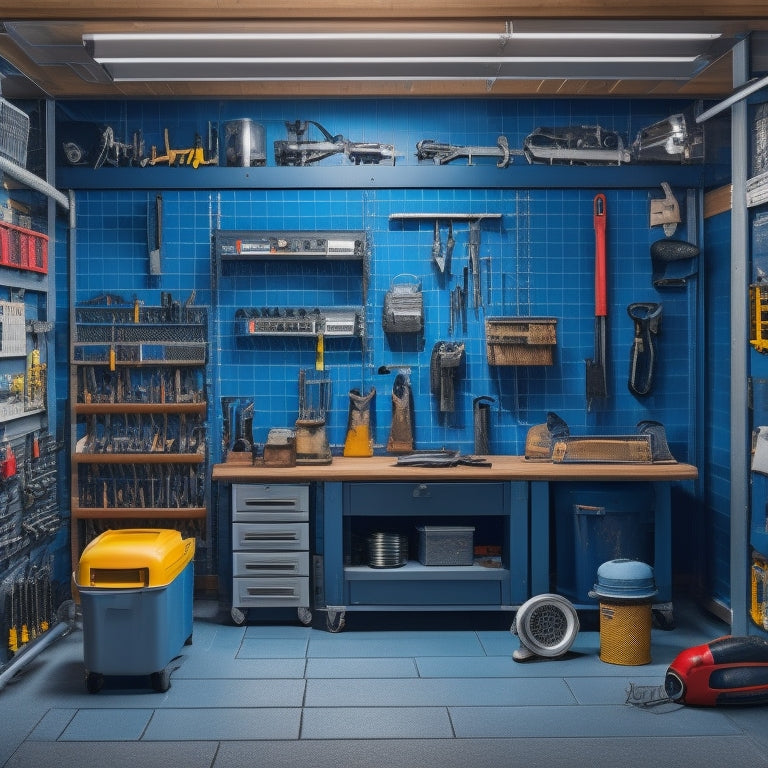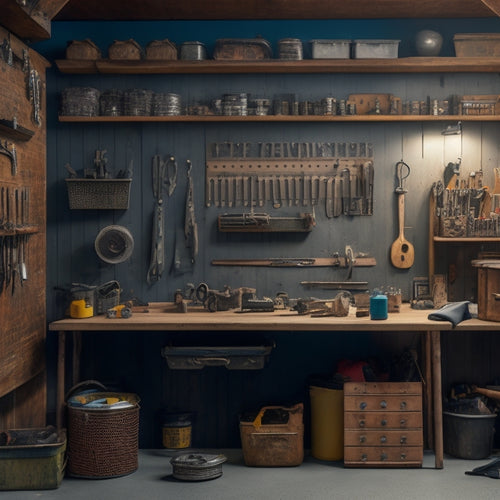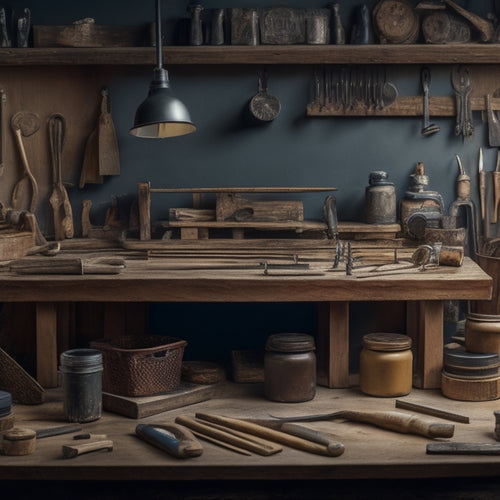
Best Tool Cabinets for Storage and Accessibility
Share
When selecting the best tool cabinets for storage and accessibility, you'll want to contemplate key features like adjustable shelves, dividers, and organizers that cater to your unique workflow. Look for cabinets with smooth-gliding drawers, rust-resistant coatings, and easy-to-clean surfaces that guarantee heavy use and maintenance. Balance storage capacity with accessibility to guarantee usability. With the right cabinet, you can improve productivity by up to 30% and create a clutter-free workspace. By understanding your specific needs and exploring top-rated options, you'll be well on your way to optimizing your tool storage and accessibility - and uncovering even more ways to enhance your workflow.
Key Takeaways
- Adjustability is key: look for tool cabinets with adjustable shelves, dividers, and organizers to customize storage for unique workflows.
- Balance storage capacity and accessibility to ensure usability, considering cabinet size, door swing clearance, and ergonomics.
- Optimize tool cabinet size and capacity by selecting the right fit for available space and tool inventory, with compact or modular designs.
- A well-designed organizer system should include modular components, ergonomic features, and labeling for efficient tool access and reduced strain.
- Durability and build quality are crucial, with high-quality materials, sturdy construction, and rust-resistant finishes ensuring reliable service and tool protection.
Top-Rated Tool Cabinets Review
Your search for the perfect tool cabinet ends here. You've likely spent hours scouring the market for a reliable storage solution that meets your specific needs. Seek no further!
We've compiled a list of top-rated tool cabinets that prioritize tool cabinet maintenance and innovative storage solutions.
You'll find cabinets with advanced features like adjustable shelves, dividers, and organizers that keep your tools within easy reach. These cabinets are designed to withstand the demands of heavy use, ensuring your tools remain protected and organized.
When it comes to tool cabinet maintenance, our top picks offer smooth-gliding drawers, rust-resistant coatings, and easy-to-clean surfaces. You'll appreciate the attention to detail that goes into each cabinet's construction, ensuring years of reliable service.
With innovative storage solutions like adjustable compartments and customizable layouts, you'll be able to tailor your cabinet to your unique workflow. By investing in one of these top-rated tool cabinets, you'll be safeguarding your tools and streamlining your work process.
Key Features to Consider
When selecting a tool cabinet, you'll want to take into account the cabinet size options that fit your available space and tool inventory.
You'll also need to assess the organizer system design, which can greatly influence the cabinet's overall functionality and accessibility.
Cabinet Size Options
You'll need to contemplate the cabinet size that best fits your workspace and storage requirements. The ideal cabinet dimensions will depend on the available floor space, the number of tools you need to store, and the frequency of access.
Consider compact cabinets for small workshops or garages, while larger workshops may require more extensive storage solutions.
When evaluating cabinet size options, measure the space where the cabinet will be installed and consider the door swing clearance. Verify the cabinet fits comfortably, leaving enough room for easy access and maneuverability.
Typically, tool cabinets range from 24 to 60 inches in width, 18 to 36 inches in depth, and 30 to 72 inches in height. Some cabinets may be designed for corner installation, optimizing space in tight areas.
Choose a cabinet that balances storage capacity with accessibility. A larger cabinet may provide more storage, but it may also be heavier and more difficult to move. Conversely, a smaller cabinet may be more portable but may not offer sufficient storage.
Assess your specific needs and select a cabinet size that strikes the right balance between storage and accessibility.
Organizer System Design
Three essential components of an effective tool cabinet organizer system design are the drawer layout, shelf configuration, and storage accessories. These elements work together to guarantee your tools are safely stored and easily accessible.
When designing your organizer system, consider the following key features:
-
Modular systems: Look for cabinets with modular compartments that can be easily rearranged or added as your tool collection grows.
-
Ergonomic design: Opt for a design that allows you to access frequently used tools at a comfortable height, reducing strain on your back and joints.
-
Adjustable shelves and dividers: Confirm shelves and dividers can be adjusted to accommodate tools of varying sizes, keeping them organized and preventing clutter.
-
Labeling and signage: Incorporate labeling and signage to identify contents at a glance, saving you time when searching for specific tools.
-
Security features: Consider cabinets with locking mechanisms or limited-access compartments to protect essential tools from theft or unauthorized use.
Benefits of Mobile Tool Cabinets
Because versatility is key in fast-paced workshops, mobile tool cabinets have become an essential component of many professionals' arsenals. You can't afford to waste time searching for the right tools or equipment when you're in the middle of a project. That's where mobile tool cabinets come in – they provide portable storage that allows you to move your tools and equipment wherever you need them.
With a mobile tool cabinet, you can easily reconfigure your workspace to accommodate different projects or tasks. This flexibility is especially important in workshops where space is limited or where multiple projects are being worked on simultaneously. By having your tools and equipment organized and readily accessible, you can reduce downtime and increase productivity.
Mobile tool cabinets also promote workspace mobility, allowing you to move your tools and equipment to the job site or to different areas of your workshop as needed. This not only saves time but also reduces the risk of accidents and injuries caused by tripping over cords or tools left on the floor.
Tool Organization and Layout
You'll want to strategically place your tools within the cabinet to maximize accessibility and reduce workflow disruptions.
Ideal tool placement involves categorizing and grouping similar tools together, while also considering the frequency of use and the order in which you typically access them.
Optimal Tool Placement
Within the confines of your tool cabinet, a well-thought-out layout can greatly improve your productivity and efficiency. When it comes to ideal tool placement, you want to make certain that your most frequently used tools are easily accessible, reducing the time spent searching for them. This not only saves you time but also reduces the risk of accidents caused by haste or frustration.
To achieve ideal tool placement, consider the following layout strategies:
-
Group similar tools together: Store tools of the same type or function in close proximity to reduce searching time and improve tool accessibility.
-
Prioritize frequently used tools: Place your most frequently used tools in easy-to-reach locations, such as the top shelf or in a designated "quick-grab" area.
-
Label and categorize tools: Use clear labels and categorize your tools to make certain you can quickly identify where a specific tool is stored.
-
Keep heavy tools at the bottom: Heavy tools should be stored at the bottom of your cabinet to prevent them from falling and causing injury.
-
Leave space for tool maintenance: Leave enough space in your cabinet to accommodate tool maintenance, such as cleaning and sharpening, to make certain your tools remain in good condition.
Efficient Workspace Design
A well-designed workspace can greatly enhance your productivity and efficiency. When it comes to tool organization and layout, you want to guarantee that your workspace flow is optimized. This means arranging your tools and equipment in a way that minimizes walking distances, reduces bending, and eliminates clutter.
Incorporate ergonomic design principles to create a safe and comfortable working environment. Position frequently used tools at waist level to reduce straining and bending. Store heavy or bulky items near the floor to prevent them from falling and causing injury.
Consider a U-shaped workstation layout to keep all your tools within easy reach, reducing the need to stretch or walk around.
Implement a "clean as you go" policy to maintain a clutter-free workspace. Assign a designated spot for each tool and label it clearly to encourage accountability and discipline.
Size and Capacity Options
Your tool cabinet's size and capacity are critical factors in determining its storage potential and ease of use. When selecting a tool cabinet, consider the space you have available and the number of tools you need to store. A cabinet that's too small will lead to clutter and disorganization, while one that's too large will waste precious space.
To optimize your tool cabinet's size and capacity, look for the following features:
- Compact storage options, such as drawers or shelves with adjustable dividers, to maximize vertical organization and minimize wasted space
- Cabinets with modular designs that allow you to add or remove components as needed
- Units with adjustable shelving to accommodate tools of varying sizes
- Cabinets with built-in pegboards or hooks for hanging tools and accessories
- Options with extendable or foldable designs for flexibility in tight spaces
Durability and Build Quality
Selecting a tool cabinet that's the right size and capacity is only half the battle; the durability and build quality of your cabinet are equally important considerations. You need a cabinet that can withstand the rigors of daily use, harsh environments, and heavy tool loads.
Look for cabinets made from high-quality material types, such as heavy-gauge steel, stainless steel, or resilient polymers. These materials provide excellent strength, corrosion resistance, and durability.
Construction methods also play a critical role in ensuring the cabinet's build quality. Look for cabinets with sturdy welding, sturdy hinges, and secure latches. The shelves and drawers should be reinforced to prevent sagging or collapse under heavy loads.
Additionally, consider cabinets with powder-coated or rust-resistant finishes to protect against corrosion. A well-built tool cabinet will provide years of reliable service, keeping your tools organized, protected, and within easy reach.
Budget-Friendly Options Available
Many tool cabinets on the market offer impressive durability and build quality, but at a hefty price tag.
If you're on a tight budget, don't worry – you can still find a reliable tool cabinet that meets your DIY tool storage needs without breaking the bank.
Here are some budget-friendly options available:
-
Compact Cabinet Solutions: Look for compact cabinets that are designed specifically for small spaces. These cabinets are often more affordable and can be easily installed in your garage or workshop.
-
Basic Tool Cabinets: Consider basic tool cabinets that offer essential storage features without the frills. These cabinets may not have fancy features, but they'll get the job done.
-
Used or Refurbished Tool Cabinets: You can find great deals on used or refurbished tool cabinets online or at local hardware stores. Just make sure to inspect the cabinet thoroughly before purchasing.
-
DIY Tool Storage Kits: If you're handy, consider DIY tool storage kits that allow you to build your own cabinet. These kits are often cheaper than pre-assembled cabinets.
-
Discounted Brands: Keep an eye out for discounted brands or last season's models, which can offer significant savings without compromising on quality.
Frequently Asked Questions
Can Tool Cabinets Be Customized to Fit Specific Tool Collections?
You can customize tool cabinets to fit your specific tool collection by exploring various customization options, such as adjustable shelves, dividers, and pegboards, which enable efficient tool organization and guarantee safe storage and easy access.
Are Tool Cabinets Suitable for Outdoor or Garage Use?
As you brave the elements, you'll find that tool cabinets can be your trusted companion, with many offering weather resistance and portability options, ensuring your tools stay protected and within reach, even in harsh outdoor or garage environments.
Can Tool Cabinets Be Locked for Added Security?
You guarantee tool security by selecting cabinets with strong locking mechanisms, such as digital locks, cam locks, or disc tumbler locks, which provide varying levels of protection against unauthorized access and theft.
Do Tool Cabinets Come With Built-In Work Surfaces?
You'll find that many tool cabinets come equipped with built-in features, including work surfaces that provide advantages like increased productivity and reduced fatigue, allowing you to efficiently complete tasks while maintaining a safe and organized workspace.
Are Tool Cabinets Compatible With Pegboard Accessories?
When shopping for a tool cabinet, you'll find many models offering pegboard integration, allowing you to customize your tool organization and maximize storage space, ensuring a safe and efficient workspace that meets your specific needs.
Conclusion
You've finally found the perfect tool cabinet to get your workspace organized and running like a well-oiled machine. Remember, a good tool cabinet is not just about storage, it's about accessibility and efficiency. When you've got the right tools at your fingertips, you'll be cooking with gas, tackling projects with ease and precision. With the top-rated options outlined above, you'll be well on your way to a clutter-free workspace that enhances productivity and takes your projects to the next level.
Related Posts
-

Design Considerations for a Custom Pegboard
When designing a custom pegboard, you'll want to start by evaluating your storage needs, considering factors like too...
-

Top 5 Small Tool Organizers for Your Workshop
You're looking to optimize your workshop's efficiency with high-quality small tool organizers. Compact storage soluti...
-

Best Materials for Garage Wall-Mounted Cabinets
When selecting materials for your garage wall-mounted cabinets, you'll want to evaluate options that balance durabili...


